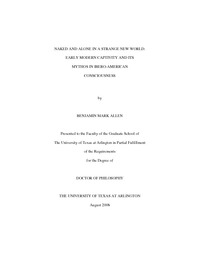
ATTENTION: The works hosted here are being migrated to a new repository that will consolidate resources, improve discoverability, and better show UTA's research impact on the global community. We will update authors as the migration progresses. Please see MavMatrix for more information.
Show simple item record
| dc.contributor.author | Allen, Benjamin Mark | en_US |
| dc.date.accessioned | 2008-09-17T23:34:57Z | |
| dc.date.available | 2008-09-17T23:34:57Z | |
| dc.date.issued | 2008-09-17T23:34:57Z | |
| dc.date.submitted | August 2008 | en_US |
| dc.identifier.other | DISS-2143 | en_US |
| dc.identifier.uri | http://hdl.handle.net/10106/1038 | |
| dc.description.abstract | This study compares and contrasts early modern (1500 - 1650) American captivity narratives of Jerónimo de Aguilar, Gonzalo Guerrero, Juan Ortiz, Cabeza de Vaca, Hans Stade, Hernando d'Escalante Fontaneda, Fray Francisco de Avila, and Francisco Núñez de Pineda y Bascuñán. Although originally touted as "true histories," they should be seen primarily as literary works imitative of popular heroic lore that suffused 16th-century Iberia and Europe. Because the chroniclers penned the narratives years after the experience, subjective memory supplanted objective empiricism. The narrators employed acceptable literary conventions highly imbued with Christian and medieval ritual and imagery to express physical and mental rites of passage. Considering the mythical archetypes and that very little factual corroboration exists, this dissertation argues that the narratives should not be regarded as reliable records of historical events. They are, however, cultural artifacts that are useful in understanding the larger psycho-social dynamics of the transatlantic world; thus, they aid construction of a histoire des mentalités that contributes to an understanding of the mythos that defined the captivity experience as a microcosm of the larger play between European and American peoples.
Through a textual-contextual analysis premised on structural, functional and psychoanalytic theories of myth and ritual, the study posits that the first-person narratives evidence the captives' negotiation of the dichotomous European and Amerindian cultures in attempts to survive and gain acceptance. The writing of the narrative served as a rite of passage back to Christendom and as an expression of the spiritual essence of the ordeal that defied description. It can also be demonstrated that other contemporary authors, like Garcilaso de la Vega, el Inca, employed mythical convention to make sense of captivity experiences for the reader and to embellish Spanish exploits so as to justify imperial prerogatives.
While contemporary narrators cast their characters as Christian heroes, post-colonial Latino authors celebrated some of the early captives as embodiments of mestizaje considering their rejection of "Spanish-ness" and embrace of "Indian-ness." This juxtaposition of contemporary with post-colonial treatments of the early modern captivity sagas further substantiates that, because of their mythical aura, the narratives offer unique insight into individual and cultural mentalities, but they are not reliable records of what actually happened during the captivity experience. | en_US |
| dc.description.sponsorship | Richmond, Douglas W. | en_US |
| dc.language.iso | EN | en_US |
| dc.publisher | History | en_US |
| dc.title | Naked And Alone In A Strange New World: Early Modern Captivity And Its Mythos In Ibero-American Consciousness | en_US |
| dc.type | Ph.D. | en_US |
| dc.contributor.committeeChair | Richmond, Douglas W. | en_US |
| dc.degree.department | History | en_US |
| dc.degree.discipline | History | en_US |
| dc.degree.grantor | University of Texas at Arlington | en_US |
| dc.degree.level | doctoral | en_US |
| dc.degree.name | Ph.D. | en_US |
| dc.identifier.externalLink | https://www.uta.edu/ra/real/editprofile.php?onlyview=1&pid=1214 | |
| dc.identifier.externalLinkDescription | Link to Research Profiles | |
Files in this item
- Name:
- umi-uta-2143.pdf
- Size:
- 1.292Mb
- Format:
- PDF
This item appears in the following Collection(s)
Show simple item record


